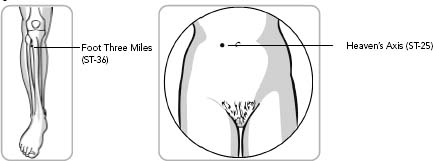AVOID
• Excessive physical and mental activity, all kinds of stress, and overeating. Get plenty of sleep.

• Alcohol, smoking, and caffeine, as using them will weaken vital energy in the long run.

• Developing food allergies, and practice food rotation—don’t repeat any one food within four days of eating it. For CFS, eliminate nightshade vegetables including tomatoes, potatoes, bell peppers, and eggplant.

• Anxiety and emotional turmoil, which burn out the vital energy.
COLD AND FLU
ONE IN THREE AMERICANS SUFFERS a seasonal cold at least once a year. The incidence rate is higher in schoolchildren, the elderly, and immune-compromised individuals. Though considered common, a cold can have severe health repercussions. Colds occur more during the fall and winter seasons, and the influenza virus likes to make its annual visit sometime in the fall. The early symptoms of a common cold include general malaise, chills, stiff neck, stuffy or runny nose, sneezing, and headaches. As the condition progresses, fever, sore throat, cough, stomach disturbances, and diarrhea may occur. The flu, as a result of the mutating influenza virus, is a more severe form of the common cold. It displays most of the same symptoms, though with more intensity and with the addition of rapidly rising fever, body aches, and vomiting.
Chinese medicine classifies the common cold as a wind pathogen that invades from the exterior. Wind cold is differentiated from wind heat, based on the finer differences between a cold and the flu. Wind cold usually occurs during seasonal changes and as a result of exposure to drafts, or even excessive exposure to air-conditioning. At this early stage, Chinese medicine suggests that perspiration is helpful in removing the pathogen from the skin. Common warming foods are used for this. Wind heat, in contrast, is characterized by high fever, sweating, sore throat, cough, headaches, and a yellow nasal discharge. It requires herbal prescriptions to clear the pathogen and relieve the symptoms. Acupuncture is widely used to treat the common cold, and there are many time-tested herbal formulations for upper respiratory infections. During the SARS epidemic in Asia, many hospitals and doctors’ offices were offering these formulas as preventives. During the cold and flu seasons, I see many patients in my office. In addition to administering treatments, I educate them on simple ways to avoid catching a cold or the flu.
Here are some recommendations.
DIET
• For wind cold, warming and dispersing foods are encouraged to promote perspiration and expel the pathogen. These include ginger, garlic, mustard greens and seeds, grapefruit peel, cilantro, parsnips, scallions, basil, and cinnamon. Eat as little as possible so as not to burden the immune system, and drink plenty of warm fluids such as soups, porridges, and tea.

• For wind heat, cooling, soothing, and heat-clearing foods are best. Favor fresh fruits and vegetables like cabbage, burdock root, cilantro, dandelion, mint, chrysanthemum flowers, apples, pears, and bitter melon. Drink plenty of room temperature water or tea.

• For both wind cold and wind heat, avoid overeating. Avoid heavy, rich, greasy foods and meats and shellfish. Also stay away from astringent substances, such as vinegar, which close the pores and “trap the thief in the house.”
HOME REMEDIES
• For wind cold, make a tea by boiling 1 chopped garlic clove, 3 slices of ginger, 1 chopped scallion, some basil, and a pinch of cinnamon in 3 cups of water for 5 minutes. Strain. Drink the tea hot and get into bed. Cover up and prepare to sweat. Sweating opens the pores, releasing trapped pathogens from the skin. Drink at least 3 cups of this tea every day until symptoms subside.

• Fill an 8-ounce squeeze bottle with 1 teaspoon sea salt. For wind cold, irrigate your sinuses with warm salt water twice daily to clean your nasal passageways. Gargle with warm salt water to relieve sore throat and take hot baths with Epsom salts to sweat.

• For wind cold, make a tea by boiling 1 whole lemon, 1 teaspoon cayenne pepper, and 1 tablespoon honey in 3 1/2 cups of water for 10 minutes. Strain, and drink 3 cups a day.

• For wind heat, juice a head of cabbage, 1 cup dandelion greens, 2 cucumbers, and 2 oranges. Drink 3 glasses daily.

• Boil a pot of water and turn off the heat. Add 10 drops of Tonic Oil (available at www.askdrmao.com), which consists of oils of camphor, peppermint, eucalyptus, fennel, and wintergreen, traditionally used for opening passageways and relieving joint pain. Inhale the fumes deeply for 10 minutes, covering your head and the pot with a towel.

• Make a tea with 1/2 cup fresh mint leaves and 1/2 cup dried chrysanthemum flowers by boiling in 4 cups of water for 20 minutes. Strain, and drink 3 cups daily. Drink throughout the day.
DAILY SUPPLEMENTS
• Up to 50 milligrams of zinc taken daily can help reduce the symptoms of a common cold.

• Up to 3,000 milligrams of vitamin C taken daily has been shown to reduce the duration of a cold.

• Vitamins E (800 IU), A (200 IU), and the B complex are antioxidants that help support healthy immune function.

• Thymus extract (200 milligrams) can help stimulate the immune system.
HERBAL THERAPY
• Herbs can be found in health food or vitamin stores, online, and at the offices of Chinese medicine practitioners. Herbs should be used according to individual needs; consult with a licensed practitioner for a customized formulation. To learn more about the herbs listed here, go to www.askdrmao.com.

• Ginger, kudzu, osha, yarrow, garlic, and astragalus can help fight off a cold at the onset. Take at the first signs of a cold.

• Andrographis has been shown to reduce the symptoms of a cold and shorten its duration.

• Make a tea by boiling 2 tablespoons of dried elderberry in 1 1/4 cups of water for 10 minutes. Strain, and drink 3 cups a day until the symptoms subside.

• I recommend our Cold/Flu Elixir, a Chinese herbal formula that supports a healthy immune system and can temporarily relieve cold symptoms. It contains honeysuckle, forsythia, schizonepetae, siler, kudzu, isatis, arctium, peppermint, figwort, apricot kernel, licorice, and other Chinese herbs.
EXERCISE
When you have a common cold, excessive exercise will deplete the body of vital qi, which is needed to fight the pathogen. I recommend rest and calm. A qi gong exercise called the Dragon Dance helps with circulation and promotes opening of the pores. It should be done indoors and not too vigorously.
This exercise resembles a belly dance—it is a wriggling rhythmic dance of the torso that burns energy and promotes fat burning in the abdomen.
In a comfortable, quiet place stand with your feet together and ankles touching, or as close together as you can get them. Place your hands over your head, with palms together and fingers pointing up. Be sure to keep your palms together during the entire exercise.
Inhaling, push your waist out to the right side while keeping your head and upper torso straight. Simultaneously move your right elbow to the right, so that it rests at shoulder height.
Exhaling, push your waist out to the left side while keeping your head and upper torso straight. Simultaneously move your left elbow fully to the left at shoulder height.
Repeat this movement several times. Every time you move your waist to the right, bend your knees a little more, lowering your entire body as you squat. Be sure to keep your upper torso and head straight.
With each movement to the right, move your hands lower, keeping your palms together and fingers pointing up. When your arms reach your chest, turn your fingers toward the ground and continue the movement.
When your arms reach your knees, you should be squatting. Continue the movements, now rising with each right movement until you reach the standing position. When your arms reach your chest, switch the direction of your fingers so that they’re pointing up again.
Throughout this exercise your hands should make an S-shaped movement and your body should perform a rhythmic belly dance. Remember to inhale on the rightward movement and exhale to the left.
Do this exercise during the day on an empty stomach. Begin slowly and increase speed and vigor, warming up the whole body, but not to the point of perspiration
ACUPRESSURE
• Locate the acupoint Valley of Harmony (LI-4), in the web between your thumb and index finger on your right hand. Apply steady pressure with your left thumb until you feel soreness. Hold for 2 minutes. Repeat on the left hand. This is traditionally used to support immune functions and detoxification.

• Locate the acupoint Wind Pond (GB-20), in the natural indentation at the base of your skull on either side of your neck. Press and lift up toward the base of your skull with your thumbs and lean your head back. Use the weight of your head against your thumbs for a steady pressure. Hold for about 5 minutes, breathing deeply and slowly.
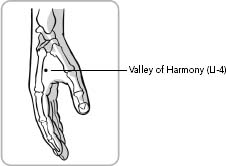
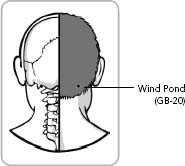
AVOID
• Excessive activity, straining, and overeating. Get plenty of sleep.

• Alcohol, smoking, and caffeine, which adversely affect energy and immunity.
COLD HANDS AND FEET
LIMBS GET COLD WHEN BLOOD VESSELS constrict or become obstructed. The hands or feet may change in color from pink to purple, blue, or white. Causes include exposure to extreme cold, poor circulation due to heart disease, frostbite, stress, side effects of medications, and prolonged work with vibrating equipment such as jackhammers. Raynaud’s syndrome is a disorder that constricts the flow of blood to the fingers and toes, and shows up as cold hands and feet. Some people who suffer from low thyroid function experience cold hands and feet, as the thyroid controls and maintains body temperature. Cold extremities are more common in women than in men.
Chinese medicine considers coldness in the body to be a lack of or diminished flow of the body’s yang, or fire energy, or as the result of insufficient blood. Since cold hands and feet are common to many imbalances, this symptom often abates when patients are well. I stress to my patients that changes to diet and lifestyle, along with exercise, can help relieve the symptoms. If the symptoms persist, as with Raynaud’s disease, I often use acupuncture to increase circulation of the warming yang energy and prescribe herbal remedies to nourish the blood and vitality.
Here are some of my favorite recommendations.
DIET
• Eat plenty of omega-3–rich foods, such as mackerel, herring, salmon, and anchovies. Emphasize blood-building meats such as lamb, beef, and wild game as well as iron-rich foods like spinach, broccoli, prunes, figs, raisins, oats, spelt, quinoa, sunflower and sesame seeds, walnuts, chestnuts, yams, squash, kale, onions, leeks, chives, garlic, scallions, parsley, parsnips, and jujube date. Liberally use spices such as cinnamon, turmeric, ginger, black pepper, fennel, anise, cardamom, and cayenne pepper. Drink only warm or hot water.

• Avoid raw foods and icy-cold foods and beverages as well as alcohol and coffee. Avoid foods containing preservatives and additives as well. Although alcohol may temporarily be warming, it actually lowers body temperature.
HOME REMEDIES
• Make a tea by steeping 1 teaspoon ground cinnamon and 1 teaspoon ground cloves in 3 cups of hot water. Drink 1 cup of this tea in the evening to warm your insides, and to encourage a good night’s sleep.

• Wear socks and gloves to bed to maintain warmth in the extremities.

• Take a hot spice bath by boiling the following spices in a large pot for 15 minutes: 1 tablespoon each of crushed black pepper, cayenne pepper, ginger, cinnamon, rosemary, oregano, sage, and cumin. Pour the mixture into the bathtub through a strainer and fill the tub with hot water. You’ll feel warmed by the spices and you’ll also smell good. Taking the bath before bedtime is preferable, but anytime will do.
DAILY SUPPLEMENTS
• Taking a daily dose of vitamin B3 (100 milligrams), or niacin, can be helpful in treating Raynaud’s phenomenon.

• Taking omega-3 fish oils (1,000 milligrams EPA; 800 milligrams DHA) on a daily basis may also help treat cold hands and feet.

• Evening primrose oil or borage oil provides a good source of GLA (gamma-linolenic acid; 400 milligrams), an essential fatty acid that has been shown to reduce symptoms of Raynaud’s syndrome.
HERBAL THERAPY
• Herbs can be found in health food or vitamin stores, online, and at the offices of Chinese medicine practitioners. Herbs should be used according to individual needs; consult with a licensed practitioner for a customized formulation. To learn more about the herbs listed here, go to www.askdrmao.com.

• Using ginkgo, turmeric, cinnamon, and ginger can improve circulation in the fingers and toes.

• I recommend our Chinese herbal formulation Dragon Male, which supports healthy circulation and warms the yang energy of the body. It contains naturally shed deer antler velvet, ginseng root, morinda root, cistanches, psoralea fruit, fennel, clove flower bud, frankincense, myrrh, horny goat weed, and other Chinese herbs.
EXERCISE
Regular physical activity is essential for smooth flow of energy in the body and for preventing blockages and promoting healthy circulation. I also recommend energy exercises like the qi gong warm-up exercise I outline below. By tapping the trunk, arms, and legs, you activate the flow of energy and blood in your body. Practice the warm-up for 15 minutes—or more often—every day.
Stand with your feet shoulder-width apart, spine erect, and head tilted slightly forward.
Make your right hand into a loose fist and begin tapping your lower abdomen with mild to moderate strength in a rhythmic fashion. Proceed to the middle and upper abdomen, then the chest.
Start tapping under the armpit of the left arm, then the inner part of the arm and down to the palm. Then tap the outer part of the arm back up to the shoulder. Tap the shoulder muscle 7 times.
Repeat the same movement with the left hand.
Begin tapping the lower back on both sides with both hands in loose fists. Move the tapping down the back of the legs to the outsides of the ankles.
Start tapping on the insides of the ankles, working your way up the insides of the calves and thighs.
Finally, return to a standing position, again tapping your lower abdomen. End by placing your palms on your lower abdomen, left hand on top of the right. Make clockwise circles, rubbing the lower abdomen 36 times.
ACUPRESSURE
• Locate the acupoint Valley of Harmony (LI-4), in the web between your thumb and index finger on your right hand. Apply steady pressure with your left thumb until you feel soreness. Hold for 2 minutes. Repeat on the left hand. This is used to unblock energy and blood stasis.

• Locate the acupoint Great Surge (LI-3), in the natural indentation on the top of your right foot between the big and second toes. Apply moderate pressure with your right thumb for 5 minutes. Repeat on the left foot. This point is traditionally used to release all types of blockages.
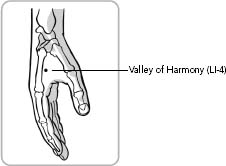
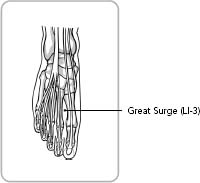
AVOID
• Smoking, as it impairs circulation.

• Caffeine, as it constricts blood vessels and can cause cold hands and feet.

• Alcohol, as its warming effects are only temporary.
CONSTIPATION
THE HUMAN BOWEL SYSTEM IS LIKE THE SEWER SYSTEM—if the sewers get clogged, the waste backs up and spills into the house. If your bowels are not moving, all the toxins and waste products of daily living remain and recirculate in your body, leading to disease. With constipation there is trouble emptying the bowels daily, and stools may be dry and hard, making them difficult to pass and forcing you to strain. In some cases, you may experience incomplete passing of the stool and feel the urge to have a bowel movement after you’ve just had one. Many people suffer from constipation in Western cultures, where sedentary lifestyle, unhealthy diet, and stress are prevalent. Constipation is caused by a fiber-deprived diet, hormonal changes, side effects from pain medications, illnesses, and, in some cases, misshapen intestines. Regular bowel movements are essential for a long, healthy, and productive life.
In Chinese medicine, the bowels are recognized as being connected to the liver and spleen digestive systems. Besides improper diet, many cases of constipation are due to prolonged stress and emotional imbalance, causing the liver energy to stagnate and preventing natural peristaltic bowel movements. Other cases of constipation involve prolonged blood and fluid deficiency, drying up the stools and making them hard to pass.
I’ve seen many patients suffering with constipation, and I often work with them in consultation with a gastroenterologist. Usually constipation is one of many symptoms of a medical condition such as irritable bowel syndrome (IBS), gallstones, colitis, Crohn’s disease, bacterial overgrowth in the small bowel, or endometriosis. My treatment for constipation focuses on discovering the primary condition and then freeing the liver energy, stimulating the natural movements of the bowels. I also address the underlying cause, be it emotional, dietary, or deficiencies of blood and fluids. I find the best success comes when the patient participates by changing his or her lifestyle. Below are some of my favorite home remedies that have been used successfully in my practice. If you experience sudden constipation lasting more than a week, you should consult your physician, as this may be a sign of a more serious condition requiring immediate attention.
DIET
• It is important to keep the bowels in healthy peristalsis with a diet rich in high-fiber foods. Favor whole grains with fiber-rich bran, legumes, fruits, and vegetables. Bananas, apples, prunes, figs, walnuts, spinach, peaches, pears, pine nuts, sesame seeds, mulberries, grapefruit, yams, avocados, adzuki beans, apricot kernels, yogurt, sprouted greens, beets, cabbage, bok choy, cauliflower, and broccoli all help keep the intestines hydrated. Fish, nuts, and seeds are rich in omega-3 fatty acids and help lubricate the intestines. Drink at least six to eight glasses of room temperature water a day.

• Do not overeat, and eliminate red meat, animal fats, fried and greasy foods, refined sugars, and simple carbohydrates, which create dampness, clogging up the digestive system.
HOME REMEDIES
• To stimulate the natural peristalsis of the bowels upon waking each morning, on an empty stomach drink a 12-ounce glass of lukewarm water mixed with 1 tablespoon honey. Walk 200 paces afterward and try to use the bathroom.

• Cook 1 cup peeled and chopped beets with 1 cup of chopped cabbage in a soup. Eat with dinner every other night for two weeks. This helps lubricate the bowels.

• Drink a glass of aloe vera juice on an empty stomach every morning for two weeks to help lubricate the bowels.
• Stew 3 to 5 prunes lightly in water for 5 minutes. Eat the prunes and drink the juice before bedtime as needed.
DAILY SUPPLEMENTS
• Taking 5 to 10 grams psyllium (in pill or powder form) three times a day with a glass of lukewarm water can help keep you regular.

• Taking 300 to 500 milligrams of aloe vera in capsule form once a day helps stimulate the intestinal tract and move the bowels.

• Taking 2 to 4 grams of flaxseed in either liquid or pill form twice each day can deliver the necessary amount of omega-3 fatty acids to soften stool and lubricate the bowels.
HERBAL THERAPY
• Herbs can be found in health food or vitamin stores, online, and at the offices of Chinese medicine practitioners. Herbs should be used according to individual needs; consult with a licensed practitioner for a customized formulation. To learn more about the herbs listed here, go to www.askdrmao.com.

• Taking fenugreek 3 times a day can help soften the stools, and also helps regulate blood sugar.

• Senna leaf can be taken as a powerful laxative but should be used with caution. Limit its use to less than 10 days; otherwise it can become addictive.

• Chinese herbs such as peach kernel, plum kernel, apricot kernel, biota seed, pine nut, and tangerine peel have lubricating and stool-softening properties. These can be used long term without side effects.

• For supporting healthy bowel function I often recommend our Chinese Internal Cleanse Tea. It contains cassia seed, dandelion, hawthorn, chrysanthemum, mulberry leaf, and other herbs. I drink it regularly myself to support the cleansing function of my body.
EXERCISE
One of the biggest causes of constipation is leading a sedentary life. Continual inactivity dramatically reduces stimulation to the digestive tract. Just like those of a hibernating bear, our bowels shut down. A simple activity like a 30-minute brisk walk each day helps stimulate the leg and thigh muscles, where the stomach and liver energetic meridians traverse.
Here is a simple 15-minute abdominal massage used to promote bowel movement function. Do this massage daily.
Lie on your back and bend your knees slightly to a comfortable position.
Begin a circular massage of the abdomen, with both palms moving together: Starting from the lower right side and with moderate pressure, rub your abdomen in small clockwise circles with your palms. Keep making small circles with the hands as you slowly traverse the abdomen around the navel.
When you reach the lower left abdomen lift your arms and begin again from the lower right abdomen. Continue for 10 to 15 minutes.
ACUPRESSURE
• Find the acupoint Valley of Harmony (LI-4), at the web between your right thumb and index finger. Apply steady pressure with your left thumb until you feel soreness. Hold for 2 minutes. Repeat on the left hand.

• Find the acupoint Upper Great Opening (ST-37) by measuring 2 hand-widths or 8 fingers below the outer indentation of your right knee next to your shinbone. Apply steady pressure with your left thumb until you feel soreness. Hold for 2 minutes. Repeat on the left leg.
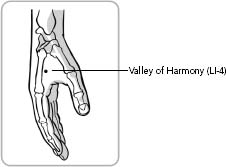
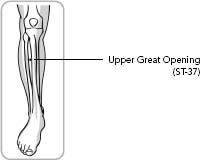
AVOID
• A sedentary lifestyle, inactivity, and prolonged sitting, which suppress natural intestinal peristalsis.

• Smoking, alcohol, and coffee, which tend to be dehydrating, making constipation worse.

• Resisting the urge to move your bowels when necessary, which can contribute to abnormal bowel habits and constipation.

• Some antacids, especially those containing aluminum, calcium, and iron supplements, as they can cause constipation.
COUGH
COUGHING IS YOUR BODY’S NATURAL RESPONSE to foreign substances in the airways or the throat. It is triggered by the nervous system, which produces a spasm of the muscles in the chest, pushing the air out of the lungs at an incredible speed (measured at 300 miles per hour). Anything from a common cold to respiratory infections, chronic obstructive disorders, and smoking can cause a cough. Most of the time when the underlying condition is removed, coughing resolves itself. In some chronic cases, prolonged coughing can strain the chest muscles, causing pain, injuring the rib cage, or even causing spontaneous pneumothorax, a condition in which a portion of the tissue separating the lungs collapses.
In Chinese medicine, a cough, like nausea and vomiting, is considered a rebellious upsurge of energy. It’s often a result of pathogens in the lungs, and sometimes it can be due to emotional turmoil aggravating the liver-gallbladder network, whose energy surges upward and injures the lungs. Most of the cough cases I treat are the result of common colds, allergies, or respiratory infections. As I mentioned in the bronchitis section, many are also due to acid reflux. I see the best results when I use acupuncture and cupping therapies to quickly relieve the cough, followed by fast-acting herbal therapy to soothe the bronchial tubes, redirect the energy downward, open the lungs to promote respiration, and remove the underlying condition.
Mucus or phlegm is often a culprit in a chronic cough. In Chinese medicine, the saying “The spleen creates dampness and mucus and the lungs are the storehouse” explains how diet and digestive weakness cause a buildup of dampness and phlegm that accumulates in the lungs, leading to a rebellion of the lung energy. In many cases, reducing and clearing out the mucus will ease the cough. I have worked with many pulmonary specialists over the years, and I tell my patients that if a cough persists beyond a month without improvement, they should immediately see a lung specialist for further examination.
Follow the simple recommendations below to help with your cough.
DIET
• For dietary advice for a cough associated with a common cold, refer to the section on common colds.

• I recommend a diet rich in complex carbohydrates, low in fat, and moderate in protein. Eat green vegetables, cabbage (both green and red), celery, daikon radish, garlic, green beans, button mushrooms, mustard greens, onions, leeks, parsnips, seaweed, turnips, water chestnuts, watercress, apples, bananas, apricots, figs, grapefruits, mulberries, oranges, pear apples, persimmons, almonds, chestnuts, walnuts, olives, and honey.

• Eliminate foods that promote mucus, including all dairy products (especially ice cream), cold and raw foods, sweet foods containing simple processed sugars, processed flour, and soft drinks.
HOME REMEDIES
• For a dry cough, finely chop 2 cups each of green and red cabbage, add 1 sliced pear apple (Asian pear), and boil in 6 cups of water for 30 minutes. Strain, and drink this broth 3 times a day.

• For a dry cough with thick yellow phlegm that is difficult to expectorate, juice 1 daikon radish and 1/2 cup water chestnuts. Warm the juice and drink with 1 teaspoon honey. Drink 3 cups a day until the mucus returns to a clear color and the cough subsides.

• For a chronic cough with excess mucus, boil 20 grapefruit seeds, 1 teaspoon mustard seeds, and 1 teaspoon parsnip seeds in 1 1/2 cups water for 10 minutes. Strain. Add 1 teaspoon honey and drink 3 times a day. Take until the cough subsides.

• For a cough with excess mucus, boil 2 oranges, including the peels, in 4 cups of water for 30 minutes. Drink 3 cups daily and eat the oranges.

• For all kinds of coughs, boil a pot of water and turn off the stove. Add 10 drops of Tonic Oil (available at www.askdrmao.com), which consists of oils of camphor, peppermint, eucalyptus, fennel, and wintergreen. Inhale the fumes deeply for 10 minutes, covering your head and the pot with a towel. This is traditionally used for opening passageways and relieving joint pain.
DAILY SUPPLEMENTS
• Supplementing with vitamins C (1,000 milligrams), E (800 IU), and B complex, bromelain (450 milligrams), garlic (900 milligrams), zinc (50 milligrams), and iron (25 milligrams) can help treat cough.

• Taking MSM (1,000 milligrams) and pycnogenol (200 milligrams), a bioflavonoid found in grape seeds, can help protect the lungs and prevent infections.

• Taking quercetin (250 milligrams) is useful for its antihistamine properties in allergic bronchitis.
HERBAL THERAPY
• Herbs can be found in health food or vitamin stores, online, and at the offices of Chinese medicine practitioners. Herbs should be used according to individual needs; consult with a licensed practitioner for a customized formulation. To learn more about the herbs listed here, go to www.askdrmao.com.

• Linden, marshmallow, and peppermint are traditionally used to suppress cough.

• Lily bulb, apricot kernel, stemona root, fritillaria, mulberry, Chinese basil, mustard seed, daikon seed, ginger, and schizandra berry are among the many herbs used in Chinese medicine to calm coughs and ventilate the lungs.

• For chronic bronchitis accompanied by kidney weakness, I recommend tonic herbs such as ginkgo seed, goji berry, cornus berry, astragalus, and ginseng.
EXERCISE
Don’t exercise strenuously during acute stages of coughing bouts, as exercise can worsen the condition. Calm and restful walks in fresh air can help. During remission, moderate physical exercise is appropriate. I recommend daily qi gong exercises to strengthen the body, open the lungs, and redirect the flow of qi downward. Eight Treasures Qi Gong is a wonderful set of qi gong movements that, when performed daily for 30 minutes, can be of great benefit to the mind and body. The fifth movement of the practice, called Water and Fire Meet, is targeted to bring the cooling and calming energy of the kidneys to the chest, to redirect the qi downward, and to calm a cough. Perform this exercise twice daily, preferably at 5:00 A.M. and 7:00 P.M.
In a quiet, comfortable environment, preferably outdoors, stand with your feet shoulder-width apart, knees slightly bent, spine erect, tailbone tucked in, and head tilted slightly forward. Place your arms palms down on your lower abdomen just below the navel, one hand overlapping the other.
Begin with rhythmic, slow, and relaxed breathing. Inhale deeply but softly, and imagine the breath extending all the way down to the lower abdomen, about two finger-widths below the navel. Exhale gently and softly. Stay in this position for 7 breath cycles, relaxing and calming your mind.
Now begin the exercise. Exhale, and bend down from your waist. Begin a gentle massage of the inner legs, starting at the inner ankles by rubbing rhythmically in a circular motion.
Inhale as you continue the massage, slowly coming up the inner calves to the inner thighs. Raise your arms slowly to your chest with the backs of your palms touching each other and your elbows bent.
When you reach the chest, make a small circular motion with your hands, moving from the middle to the outer chest with palms facing down, expanding the chest. Then move your hands from the outer to the middle of the chest, with palms facing up.
Inhale, and in an alternating fashion make circles with the bent elbows, moving from front to back and bending at the hips to exaggerate the motion slightly. Alternate between the left and right arms 3 times.
Repeat the circles now in the reverse direction from the back to the front, inhaling and exhaling with each circle. Repeat with each arm 3 times.
Bring the arms back to the center of the chest, with the back of the palms facing each other, elbows bent. Inhale and open the chest with both arms stretching back and to the sides, again with elbows bent and palms relaxed. Exhale and stretch both arms out to the sides, palms facing out as if you were pushing to the left and right sides. As you exhale, push your hands out 3 times.
To complete the exercise, return to the initial standing posture. Place your hands on your lower abdomen, palms down, one hand overlapping the other. Rub your lower abdomen 7 times in small clockwise circles just below the navel.
ACUPRESSURE
• Locate the acupoint Cubit Marsh (LU-5) by bending your right arm at the elbow and finding the point in the elbow crease, on the outer side of the large tendon in the middle of the crease. Apply moderate pressure with your left thumb until you feel soreness. Hold for 2 minutes. Repeat on the left arm.

• Locate the acupoint Upward Thrust (REN-22), on the chest, level with the clavicle and shoulders, in the depression at the center of the sternum just below the V of the neck. Apply steady pressure with your index fingers until you feel soreness. Hold for 3 minutes.

• These points are used to soothe breathing, redirect lung energy downward, and stop cough.
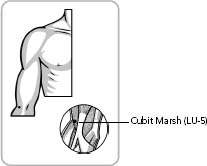
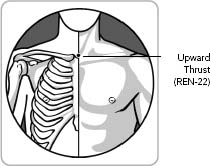
AVOID
• Exposure to airborne irritants, which can aggravate a cough.

• Alcohol, smoking, and caffeine, stimulants that can worsen the condition.

• Exposure to cold weather, which can trigger bronchial constriction and worsen a cough.

• Stress, anxiety, and emotional turmoil, which can aggravate a cough.
DANDRUFF
ALMOST EVERYONE HAS SOME DEGREE OF DANDRUFF—that’s normal. Your skin and scalp undergo regular regeneration and renewal; dead skin is shed to allow new skin to grow. This is especially evident in the scalp, where the dead skin gets tangled in the hair and forms a dry, flaky, crusty residue. This flaking can be worse in people with dry skin or in those with deficiencies of certain nutritional components. Hormonal imbalances, stress, and diet also play a role. Dandruff is worse during fall and winter, when the air tends to be dry.
In Chinese medicine, skin moisture relies on blood and the healthy function of the lungs, since the lung–large intestine network controls the skin. When there is insufficient blood to nourish the skin, the scalp becomes dry and flaky, producing dandruff. The best approach is to identify and resolve the underlying causes in order to nourish the blood and moisten the skin. Excess heat can also cause of dandruff—in this case the excess heat is most likely the result of a rich diet of deep-fried, greasy, spicy, and protein-rich foods. Too much alcohol, coffee, and sugar can cause the body’s pH to become more acidic, directly contributing to poor scalp condition. If stress, hormonal imbalances, and nutritional deficiencies are evident, lifestyle changes can help prevent or reduce the severity of the symptoms.
I had a patient in his late twenties with dandruff so severe that he was taking antidepressants to deal with the effects of the social stigma of the condition. Though he had seen several dermatologists and had used many topical medications, his condition didn’t change. I determined that he was suffering from liver energy stagnation coupled with heat from a poor diet. I put him on a cleansing and detoxification program followed by a strict vegetarian diet of fresh fruits and vegetables, beans, nuts, and whole grains for three months. I also administered weekly acupuncture and herbal therapies, and I taught him my stress release meditation, which combines simple visualization with breathing practice to reduce tension and lower stress hormones. I’m glad to report that by the end of his three-month therapy his dandruff was no longer a problem, and I hear he is dating again.
DIET
• A diet to relieve dandruff must focus on nourishing blood and should be moistening without being greasy. Eat a healthy organic diet with lots of fresh green leafy vegetables, fresh fruits, nuts, seeds, and whole grains. Animal products should be from organic sources with a low fat content. Drink plenty of room-temperature water to help irrigate the skin.

• Eliminate processed foods, artificial additives, bleached sugar, dairy products, soft drinks, and spicy, hot, fried, and oily foods.
HOME REMEDIES
• Massage aloe vera gel directly from the leaf into the scalp once a day, preferably before bedtime, for a month. Leave it on overnight and rinse it off with your morning shower.

• In the shower, wet your hands and scrub baking soda vigorously into your scalp. After rinsing off, massage Tonic Oil (available at www.askdrmao.com), which contains oils of wintergreen, eucalyptus, and menthol, into your scalp. Leave it on for 10 minutes before shampooing.

• Prepare a mild green tea, let it cool, and pour it onto your scalp. Leave it on for 10 minutes, then shampoo with olive oil or avocado oil shampoo, available at health food stores.
DAILY SUPPLEMENTS
• Supplementing with essential fatty acids (1,000 milligrams EPA; 800 milligrams DHA) from flaxseeds or evening primrose oil (450 milligrams GLA) is important for a healthy scalp.

• Taking vitamins A (200 IU), B complex, and E (800 IU) supports healthy skin and hair.

• Selenium (100 micrograms) is an excellent antioxidant to treat a dry, scaly scalp.

• Kelp (500 milligrams) supplements provide essential minerals and iodine for skin health.
HERBAL THERAPY
• Herbs can be found in health food or vitamin stores, online, and at the offices of Chinese medicine practitioners. Herbs should be used according to individual needs; consult with a licensed practitioner for a customized formulation. To learn more about the herbs listed here, go to www.askdrmao.com.

• Ginkgo biloba improves circulation to the scalp, green tea reduces sebum oil deposits, and saw palmetto helps reduce hair loss.

• Our Exquisite Skin Chinese herbal formula helps support healthy skin function. It contains siler, caltrop, schizonepetae, astragalus, peony, dong quai, Fo-Ti, rhubarb, and licorice.
EXERCISE
Regular physical exercise is important for maintaining proper circulation to the scalp. Stress-reduction exercises and meditation can also help regulate your energy and strengthen your essence. I recommend the following General Cleansing Exercise to all my patients.
Sit comfortably or lie down on your back. Slow your respiration to deep abdominal breathing. Say the word “calm” in your mind with every exhalation. You’ll be visualizing the relaxation of a body part and releasing tension with every exhalation. Trace the following three pathways outlined below.
Start at the top of your head. Inhale, then exhale and visualize your scalp muscles relaxing. Say “calm” in your mind. Repeat this word for each body part as you move down through your face, throat, chest, abdomen, thighs, knees, calves, ankles, and feet. When you’ve relaxed your feet, visualize all the tension in your body leaving through your toes in the form of dark smoke.
Next, start at the temple region of your head. This path focuses on the sides and upper extremities. Inhale, then exhale and visualize your temple muscles relaxing. Say the word “calm” in your mind. Repeat this word for each body part as you move down through your jaws, the sides of your neck, shoulders, upper arms, elbows, forearms, wrists, and hands. Once you’ve relaxed your hands, visualize all the tension leaving your body through your fingertips in the form of dark smoke.
The final pathway begins on the back of your head. This path relaxes the back of your body. Repeat the breathing-visualization-word routine, as you go from the back of your neck to your upper back, middle back, lower back, back of thighs, calves, and heels. Then focus on the acupoint Bubbling Spring (KID-1), on the soles of your feet, for 1 minute.
Practice this exercise for at least 15 minutes twice a day.
ACUPRESSURE
• Find the acupoint Three Yin Crossing (SP-6), which is traditionally used to support yin and balance hormones. Four finger-widths above the inner ankle of the right foot. Apply steady pressure with your right thumb until you feel soreness. Hold for 2 minutes. Repeat on the left foot.

• Locate the acupoint Valley of Harmony (LI-4), in the web between your thumb and index finger on your right hand. It is traditionally used to open blockages and detoxify. Apply steady pressure with your left thumb until you feel soreness. Hold for 2 minutes. Repeat on the left hand.
AVOID
• Eating chemicals, additives, and preservatives, as they can interfere with the nourishment and lubrication of the skin.

• Stress and overwork, as they can deplete the vital essence, leading to dry skin.
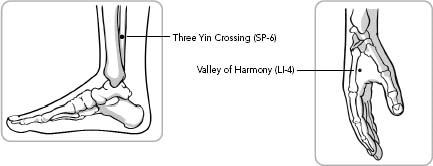
DIABETES
SUGAR—GLUCOSE, SPECIFICALLY—is the primary source of energy for every cell in the body, whether in the brain, the heart, or the muscles that help you walk. As food is digested, the sugars are changed into glucose. The glucose then travels throughout the body via the blood, and is absorbed by cells for energy. A tiny molecule called insulin, which is produced by the pancreas, makes this absorption possible. Under normal circumstances your blood sugar is usually balanced, with minor peaks after a meal. But consuming an excess of cookies, soft drinks, and processed foods that contain simple sugars, combined with inactivity and a sedentary life, can cause blood glucose levels to rise rapidly. In response, the pancreas produces excess insulin, which rapidly shuffles the blood sugar into cells, dropping levels to far below normal and resulting in cravings for more sugar. Over time this yo-yo effect can make the cells less sensitive to insulin and more sugar stays in the blood, resulting in diabetes. This phenomenon is called insulin resistance.
In ancient times diabetes was diagnosed by tasting a person’s urine for sugar content. Excess sugar in the blood eventually drains out of the kidneys, causing frequent urination, and with loss of the fluids comes thirst. Frequent urination and excessive thirst are the hallmark characteristics of diabetes. Affecting more than 20 million people in the United States, diabetes is a complex syndrome involving many of the body’s systems and has the potential to damage the heart, kidneys, nervous system, and hormonal system. If left unmanaged, diabetes can cause many complications, including heart disease, kidney failure, peripheral neuropathy, decreased wound healing, skin ulceration, and infections.
Type 2—or adult-onset diabetes—is the most common of the two main types of diabetes. Though there is no cure for diabetes, there are ways to control blood sugar. With proper diet and an approach that integrates Western and Eastern medicine, type 2 diabetes can be controlled. I work with endocrinologists to reverse or control diabetes—our patients are put on a strict diet that includes quality protein from fish, fowl, nuts, seeds, beans, and legumes. Fresh vegetables and whole grains are also part of the diet. Patients eat small but frequent meals, do at least one hour of cardiovascular exercise a day, and keep their stress levels low with meditation. I also administer weekly acupuncture treatments and Chinese herbal therapy. Initially my diabetes patients are on medication prescribed by their endocrinologist, but as their glucose levels normalize, the medications are reduced until they’re no longer necessary. This type of treatment can only be accomplished through a close collaboration between Eastern and Western medicine.
Chinese medicine has recorded many observations of diabetes throughout the millennia and classifies it as “wasting and thirsting disorder.” It has differentiated the condition into upper, middle, and lower regions of the body, depending on where the most symptoms occur. For example, excess thirst is the upper body, attributed to deficiency of the lung–large intestine network. Excess hunger is attributed to the middle and linked with the spleen-pancreas-stomach network. Excess urination is linked to the lower body organs, namely the kidneys. Depending on the symptoms, treatments focus on harmonizing these organs, strengthening weaknesses, and adjusting the body’s ability to absorb and metabolize sugar. The best approach to diabetes is, of course, prevention. With simple changes to your diet and lifestyle, along with regular checkups, you can keep this debilitating condition from entering your life.
Please note: Never go off medications or insulin without the consent of your physician.
DIET
• The key to maintaining normal sugar levels in the body is to eat a balanced diet of complex carbohydrates, organic sources of protein, and healthful fats. Eat at regular intervals and eat more often in smaller amounts. Skipping meals is a sure way of causing blood glucose to bounce up and down. Favor black beans, soybeans, tofu, garbanzo beans, mung beans, yams, peas, artichokes, pumpkin, celery, spinach, daikon radish, cabbage, water chestnuts, millet, oats, amaranth, quinoa, bran, lentils, organic chicken and turkey, fish, egg whites, unsweetened low-fat yogurt, nuts, seeds, olive oil, flaxseed oil, virgin coconut oil, and fresh berries.

• Eliminate all simple sugars and foods high in sugar, such as soft drinks, candy, honey, and molasses. Alcohol should be eliminated. Smoking and caffeine also have an adverse effect on sugar metabolism.

• Learn to read food labels. Look out for sugar, corn syrup, and dextrose as ingredients. It’s best to stay away from processed and refined products, which are devoid of healthful fiber and nutrients.
HOME REMEDIES
• Eat a slice of baked pumpkin topped with olive oil and rosemary every day.

• Boil 1/2 head chopped cabbage, 1 diced yam, and 1/3 cup lentils in 8 cups of water for 30 to 45 minutes. Season lightly with herbs and spices and eat as a soup for dinner. Have this dish 2 to 3 times a week for a month.

• Juice 1 daikon radish, 3 stalks of celery, 1 cucumber, and 1 bunch of spinach. Drink 2 glasses a day.

• Drink a tea made with 1/2 cup chrysanthemum flowers boiled for 15 minutes in 5 cups of water. Strain, and drink 3 to 4 cups a day.
DAILY SUPPLEMENTS
• Alpha lipoic acid (50 milligrams) is a powerful antioxidant used to prevent damage to the cells. It is being studied for its ability to absorb glucose in muscle tissue to relieve diabetic neuropathy and reduce sensitivity to insulin.

• Chromium (200 micrograms) can reduce sugar levels during fasting periods if taken for a period of at least two months.

• Vitamins E (800 IU) and B complex, coenzyme Q-10 (50 milligrams), and L-carnitine (500 milligrams) have been shown in some studies to support healthy blood glucose levels.

• Brewer’s yeast (500 milligrams) contains a natural glucose-tolerance factor that is necessary for producing and using insulin.
HERBAL THERAPY
• Herbs can be found in health food or vitamin stores, online, and at the offices of Chinese medicine practitioners. Herbs should be used according to individual needs; consult with a licensed practitioner for a customized formulation. To learn more about the herbs listed here, go to www.askdrmao.com.

• Fenugreek, garlic, bilberry, ginseng, and gymnema are beneficial for treating diabetes.

• Traditional herbs that have been used for wasting and thirsting disorders include rehmannia, Asian cornelian cherry, Chinese yam, poria, mouton, ganoderma, astragalus, ginseng, and water plantain.
EXERCISE
Keeping fit and maintaining proper weight is the best thing you can do to prevent diabetes. Exercise also plays a direct role in how your body stores and uses the energy you consume. A daily 30-minute cardiovascular activity that stimulates circulation, conditions the heart, and builds muscle will encourage your body to properly metabolize sugar, helping to prevent diabetes. Studies show that tai chi and qi gong exercises have a beneficial effect on the hormonal system. With daily practice of qi gong exercises such as the Eight Treasures you can strengthen your hormonal system, help balance your blood sugar levels, and avoid the serious complications of diabetes. Below I describe a simple walking exercise called Merry-Go-Around that I recommend to many of my patients to help manage diabetes.
In a quiet outdoor setting find a tree with at least five feet of clear space around the trunk in all directions. If you were to draw a circle around the tree, its diameter would be around 10 to 12 feet, though larger or smaller circles are also fine.
Walk around the tree with a relaxed but steady gait, with your hands raised to your trunk. With each completed circle change the position of your arms by slightly raising or lowering your hands in front or on the sides of your trunk.
For the first half of the exercise, walk clockwise around the tree. For the second half, walk counterclockwise.
Do this exercise twice a day for 15 minutes.
ACUPRESSURE
• Find the acupoint Foot Three Miles (ST-36), four finger-widths below the kneecap on the right leg. Apply moderate pressure with your right thumb until you feel soreness. Hold for 2 minutes. Repeat on the left leg.

• Find the acupoint Three Yin Crossing (SP-6), four finger-widths above the inner anklebone, in the depression near the bone on the right leg. Apply steady pressure with your right thumb until you feel soreness. Hold for 3 minutes. Repeat on the left leg.

• Engaging both of these points helps regulate digestion and metabolism, strengthens the vital qi, and tones the yin of the kidneys, spleen, and liver, which are involved in endocrine function.
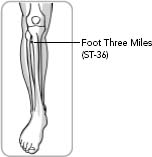
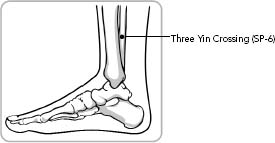
AVOID
• A sedentary life, which is a major contributor to diabetes. Get out and get physically active.

• Sugar and sweets, alcohol, and coffee; they should be off-limits.

• Stress, anxiety, and emotional turmoil.
DIARRHEA
MOST OF US GET THE RUNS NOW AND THEN. Something we eat or drink disagrees with our system and our body rejects the offending substance by expelling it through the bowels. The diarrhea soon passes and we are back to normal. But when diarrhea is a recurring condition, the impact on daily life becomes unbearable. The two biggest causes of diarrhea are diet and a stressful lifestyle. Bacteria or parasites found in uncooked or contaminated foods can cause acute diarrhea. Most chronic diarrhea is associated with either irritable bowel syndrome (IBS) or inflammatory bowel disease (IBD), which includes colitis, ulcerative colitis, Crohn’s disease, and proctitis. Dehydration is often a complication of chronic diarrhea; if unchecked, dehydration can have serious, life-threatening consequences.
In Chinese medicine, there are three possible causes of diarrhea: emotional imbalances affecting the liver system, unhealthy eating habits that damage the spleen system, and exhausting work and excess sexual activity, which deplete the kidney system. In most cases of acute diarrhea, the culprit is a pathogen from the outside, such as bacteria from contaminated food, a flu virus, or parasites. Chronic conditions always involve the liver, spleen, and kidney systems. Both acute and chronic diarrhea respond well to acupuncture and herbal therapy together with nutrition and stress management.
Often when steroids and immunosuppressant drugs fail to relieve diarrhea in IBD patients, I will get a referral from one of my gastroenterologist colleagues. The collaboration of Eastern and Western medicine has helped many patients go into remission—and stay there. Below are some remedies that my patients have found to be helpful. If you experience uncontrollable, constant diarrhea for more than forty-eight hours and experience dizziness and shortness of breath, you may be dehydrated and should go to the emergency room immediately.
DIET
• What goes in goes out, so proper eating habits are essential. Eat regularly, more often, and in smaller quantities. Favor blueberries, cinnamon, raspberry leaves, lotus seeds, white rice, green apples, toasted white bread, carob, amaranth, barley water (boil barley in water for 30 minutes; strain), sauerkraut, yams, sweet potatoes, taro root, daikon radish, winter melon, fresh fig leaves, peas, buckwheat, litchi, guava, apples, ginger, pearl barley, basil, and umeboshi plum or pickled green plum. Drink plenty of pure water. Avoid dehydration by drinking at least eight to ten 6-ounce glasses of water a day during the acute phase of diarrhea.

• Do not overeat. Avoid cold and raw foods, including ice cream and iced drinks. Keep raw vegetables to a minimum—cook or steam your vegetables. Keep dairy to a minimum, and eliminate spicy, stimulating, fried, and oily foods as well as preservatives, artificial colors, flavorings, and sweeteners. Avoid simple sugars and whole grains with the bran layer, as they may be too hard on the digestive system. Keep your kitchen clean as you prepare your food. Make sure to cut meat and animal products on cutting boards separate from those used for other foods, and wash the boards well. Avoid alcohol, as it impairs the intestinal wall’s ability to absorb water and can contribute to diarrhea.
HOME REMEDIES
• Take charcoal tablets (500 milligrams) 3 times a day until the diarrhea stops.

• Eat yogurt containing live cultures—the friendly bacteria help subdue diarrhea.

• Steep black tea in a cup of boiling water for 10 minutes. Drink 3 cups a day until the diarrhea stops.

• Eat rice cakes or dry toast sprinkled with sea salt.

• Make a tea by boiling 1 teaspoon each of ground ginger, fennel, and basil in 3 1/2 cups of water for 15 minutes. Strain, and drink 3 cups a day.

• Drink 3 cups of blackberry tea daily. Blackberry is an astringent, and it is especially good for children.
DAILY SUPPLEMENTS
• During the active phase of diarrhea it is important to keep hydrated. Drink fluids rich in electrolytes and supplement with potassium (25 milligrams) to make up for potassium loss.

• Take bromelain (450 milligrams), found in pineapples, or another digestive enzyme such as papain (300 milligrams), 3 times a day, with each meal to aid digestion and suppress diarrhea.

• Taking quercetin (400 milligrams) 3 times a day can be useful for dysenteric diarrhea.

• Taking probiotics such as acidophilus (3 to 5 billion organisms) supports healthy flora in the bowels.

• Psyllium (2 to 4 grams) and pectin powder (1 to 2 grams) are useful as bulking agents for treating diarrhea.
HERBAL THERAPY
• Herbs can be found in health food or vitamin stores, online, and at the offices of Chinese medicine practitioners. Herbs should be used according to individual needs; consult with a licensed practitioner for a customized formulation. To learn more about the herbs listed here, go to www.askdrmao.com.

• For urgent, foul-smelling diarrhea accompanied by a burning sensation in the anus and abdominal pain, herbs containing berberin, such as coptidis or goldenseal, are useful, as they’re naturally antibacterial.

• Traditional Chinese herbs to support healthy digestion and bowels include patchouli, atractylodis, magnolia bark, peony, ginger, tangerine, cardamom, fennel, and licorice.

• For IBS and diarrhea due to emotional stress, I often recommend our Chinese herbal formula Emotional Tranquility Tea, which supports healthy nervous system function and maintains calm and peace. It contains Chinese senega, lily bulb, poria, bamboo, zizyphus, dragon bone, and licorice.
EXERCISE
To help stop acute diarrhea, try this simple 15-minute abdominal massage. Note that the direction of the circles is the opposite of those in the massage for constipation.
Lie on your back and bend your knees slightly to a comfortable position.
Begin a circular massage of the abdomen, with both palms moving together: Starting from the lower left side and with moderate pressure, rub your abdomen in small counterclockwise circles with your palms.
Keep making small circles with your hands as you slowly traverse a counterclockwise path around the navel. The idea is to move opposite to the peristaltic flow of the colon.
When you reach the lower right abdomen lift your arms and begin again from the lower left side. Repeat for 10 to 15 minutes, 3 times daily.
If you have chronic diarrhea, mild exercise like tai chi or qi gong can help strengthen your energy and digestive function. I suggest the Stomach-Spleen Strengthening Qi Gong exercise to strengthen the digestive system and promote the flow of energy in the abdomen. Perform this exercise twice a day on an empty stomach.
Lie on your back, comfortably, with your hands at your sides. Focus on your navel. Visualize a golden disk the size of a Frisbee spinning around your entire abdomen with its center at your navel. With every inhalation the disk spins half of a circle. With every exhalation the disk completes the other half of the circle.
Breathe deeply so that the disk spins slowly, corresponding to your respiration, for a total of 21 times in the clockwise direction. Reverse the direction of the disk’s rotation and repeat the breathing-spinning sequence.
ACUPRESSURE
• Locate the acupoint Foot Three Miles (ST-36), four finger-widths below and to the outside of the right kneecap. Apply moderate pressure with your right thumb. Hold for 5 minutes. Repeat on the left leg. This point is often tender to the touch in people with digestive disturbances.

• Locate the acupoint Heaven’s Axis (ST-25), three finger-widths to either side of the navel. Apply steady, moderate pressure with your index fingers. Hold for 5 minutes.
